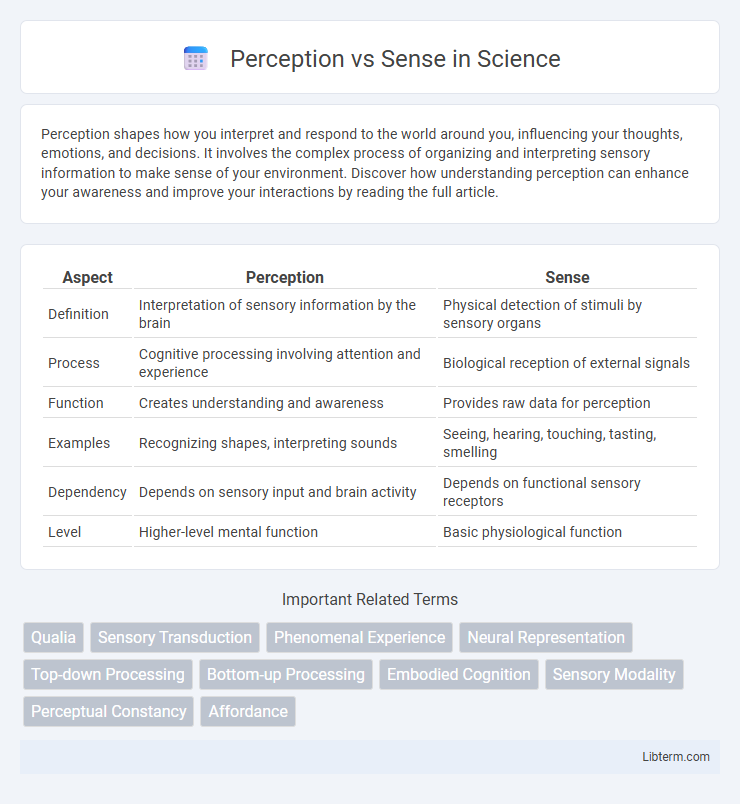Perception shapes how you interpret and respond to the world around you, influencing your thoughts, emotions, and decisions. It involves the complex process of organizing and interpreting sensory information to make sense of your environment. Discover how understanding perception can enhance your awareness and improve your interactions by reading the full article.
Table of Comparison
| Aspect | Perception | Sense |
|---|---|---|
| Definition | Interpretation of sensory information by the brain | Physical detection of stimuli by sensory organs |
| Process | Cognitive processing involving attention and experience | Biological reception of external signals |
| Function | Creates understanding and awareness | Provides raw data for perception |
| Examples | Recognizing shapes, interpreting sounds | Seeing, hearing, touching, tasting, smelling |
| Dependency | Depends on sensory input and brain activity | Depends on functional sensory receptors |
| Level | Higher-level mental function | Basic physiological function |
Understanding Perception and Sense
Understanding perception involves the brain's ability to interpret and organize sensory information, transforming raw data into meaningful experiences. Sense refers to the physiological process of detecting stimuli through organs like eyes, ears, and skin, providing the fundamental input for perception. While senses gather external signals, perception constructs awareness by integrating past knowledge and context, enabling recognition and response.
Defining Perception: Beyond the Senses
Perception extends beyond the basic senses by integrating sensory inputs with cognitive processes such as attention, memory, and interpretation to create meaningful experiences. It involves the brain's ability to organize and interpret sensory data, transforming raw stimuli into coherent understanding of the environment. This complex interaction highlights perception as an active process that shapes how individuals recognize objects, events, and spatial relationships beyond mere sensory detection.
What Are Senses? Exploring Human Sensory Systems
Senses are specialized biological systems enabling humans to detect and respond to environmental stimuli through five primary modalities: sight, hearing, taste, smell, and touch. Each sensory system comprises receptors that transduce physical or chemical signals into neural impulses, facilitating perception in the brain. Understanding sensory mechanisms highlights the distinction between raw sensory input and the interpretative cognitive process known as perception.
How Perception Interprets Sensory Input
Perception interprets sensory input by organizing and analyzing signals received from sensory organs, transforming raw data into meaningful experiences. This cognitive process involves the brain filtering, categorizing, and contextualizing sensory information to create an accurate representation of the environment. Sensory input alone consists of basic stimuli such as light, sound, and pressure, while perception adds layers of interpretation, memory, and expectation to produce coherent understanding.
The Psychological Process of Perception
The psychological process of perception involves organizing and interpreting sensory information received through the senses to create meaningful experiences of the environment. Unlike raw sensations, perception integrates past experiences, attention, and cognitive processing to form a coherent understanding of stimuli. This active process allows individuals to recognize objects, events, and spatial relationships, enabling adaptive responses.
Perception vs Sense: Key Differences
Perception involves the brain's interpretation and conscious awareness of sensory information, while sense refers to the physiological mechanisms detecting stimuli, such as sight, hearing, or touch. Key differences include that senses provide raw data from the environment, whereas perception processes this data to create meaningful experiences. Perception can be influenced by cognition, memory, and emotions, contrasting with senses that function automatically and objectively.
The Role of the Brain in Perceiving Senses
Perception is the brain's active process of interpreting sensory information received from the senses, transforming raw data from sight, sound, touch, taste, and smell into meaningful experiences. Sensory receptors transmit signals through the nervous system to specific brain regions such as the occipital lobe for vision and the temporal lobe for auditory input, where neural networks analyze and integrate this data. The brain's interpretation depends on previous knowledge, context, and attention, making perception a complex cognitive function beyond mere sensory detection.
Factors Influencing Human Perception
Human perception is influenced by sensory input quality, past experiences, expectations, and cultural background, which shape how individuals interpret stimuli. Cognitive factors such as attention, memory, and emotional state also play a crucial role in modulating sensory information into meaningful perceptions. Environmental context and social interactions further affect perception by altering focus and interpretation of sensory data.
Common Misconceptions about Perception and Sense
Perception and sense are often mistakenly used interchangeably, but perception involves the brain's interpretation of sensory input, while sense refers to the physiological detection of stimuli through organs like the eyes, ears, and skin. A common misconception is that perception is merely a passive receipt of sensory data, whereas it actively constructs reality by filtering and organizing sensory signals based on prior knowledge and context. Understanding this distinction is crucial in fields like psychology, neuroscience, and cognitive science to accurately address how humans experience and interact with their environment.
Real-World Examples: Perception vs Sense in Daily Life
Sense refers to the raw data collected by sensory organs, such as the eyes detecting light or the skin feeling temperature. Perception interprets these sensory inputs, like recognizing a red traffic light as a signal to stop or feeling cold and deciding to wear a jacket. For example, smelling food involves the sense of olfaction, while perceiving its aroma as pleasant or spoiled depends on cognitive processing.
Perception Infographic

 libterm.com
libterm.com